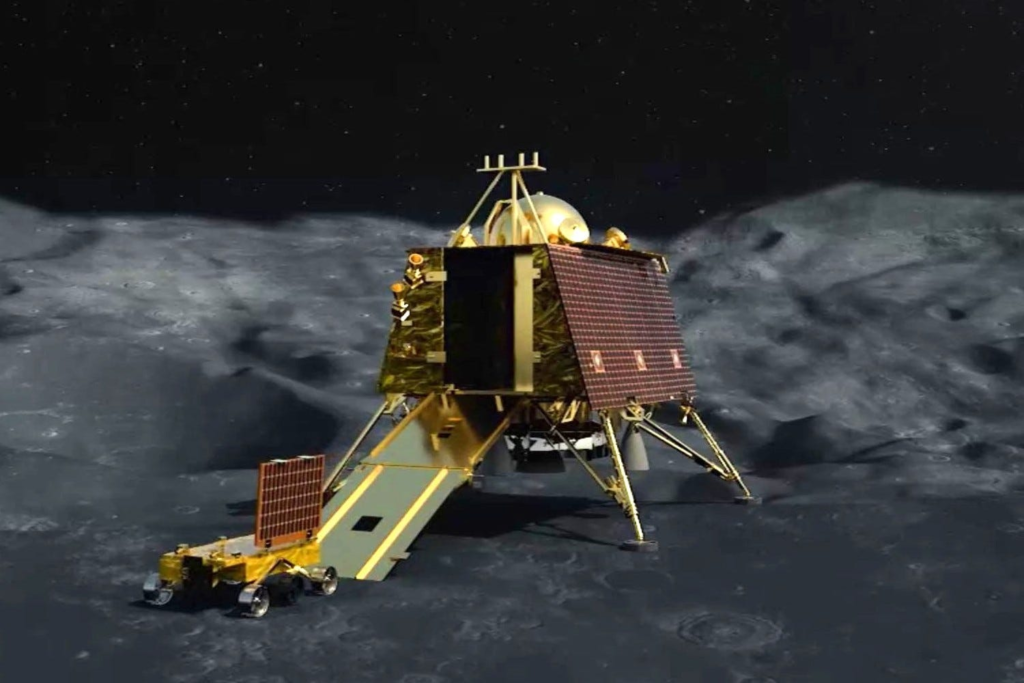Chandrayaan 3 is a follow-up mission
Chandrayaan 3 is a follow-up mission to Chandrayaan-2 and aims to demonstrate various capabilities, including safe landing, roving, and scientific experiments on the lunar surface. The mission comprises a Lander, Rover, and Propulsion Module, with advanced technologies integrated to achieve its objectives.
Chandrayaan 3 is an upcoming lunar mission that follows Chandrayaan-2. It aims to showcase safe landing, roving, and scientific experiments on the Moon’s surface. The mission includes a Lander, Rover, and Propulsion Module, all equipped with advanced technologies.

Lander for Chandrayaan 3:
- The Lander module is designed to perform a soft landing on a specified lunar site and deploy the Rover for surface analysis.
- It includes various scientific payloads:
- Radio Anatomy of Moon Bound Hypersensitive ionosphere and Atmosphere (RAMBHA): Utilizes Langmuir probe (LP) to measure plasma density and variations near the lunar surface.
- Chandra’s Surface Thermo physical Experiment (ChaSTE): Measures thermal properties of the lunar surface near the polar region.
- Instrument for Lunar Seismic Activity (ILSA): Measures lunar seismic activity, revealing the structure of the lunar crust and mantle.
- Laser Retroreflector Array (LRA): Passive experiment to study the Moon’s dynamics.

Rover for Chandrayaan 3:
- The Rover is intended to carry out in-situ chemical analysis of the lunar surface during its mobility.
- It hosts the following payloads:
- LASER Induced Breakdown Spectroscope (LIBS): Performs qualitative and quantitative elemental analysis, determining chemical and mineralogical composition.
- Alpha Particle X-ray Spectrometer (APXS): Determines elemental composition (e.g., Mg, Al, Si, K, Ca, Ti, Fe) of lunar soil and rocks near the landing site.

Propulsion Module for Chandrayaan 3:
- The Propulsion Module carries the Lander from launch to a lunar orbit of 100 km.
- It includes a scientific payload:

Mission Objectives for Chandrayaan 3:
- Safe and Soft Landing on Lunar Surface: Demonstrates the ability to land safely on the Moon’s surface.
- Rover Roving: Tests the Rover’s mobility and surface analysis capabilities.
- In-situ Scientific Experiments: Conducts various scientific experiments on the lunar surface.
Advanced Technologies:
- The Lander incorporates advanced technologies such as altimeters, velocimeters, inertial measurement systems, propulsion systems, navigation, guidance, and hazard detection systems.
- We have successfully conducted tests, including integrated cold tests, integrated hot tests, and performance tests, for the Lander’s leg mechanism.
Specifications:
- The mission’s duration is approximately one lunar day (about 14 Earth days).
- The landing site’s coordinates are 69.367621°S latitude and 32.348126°E longitude.
- The overall mass of the modules is around 3900 kg.
- Communication is established with the Indian Deep Space Network (IDSN) and possibly the Chandrayaan-2 Orbiter.
- The Lander features several sensors, actuators, propulsion systems, mechanisms, and landing specifications.


Chandrayaan 3’s objectives and detailed specifications showcase India’s commitment to lunar exploration and technological advancements. The mission aims to enhance our comprehension of the Moon’s composition and characteristics, while also laying the groundwork for future interplanetary endeavors.

